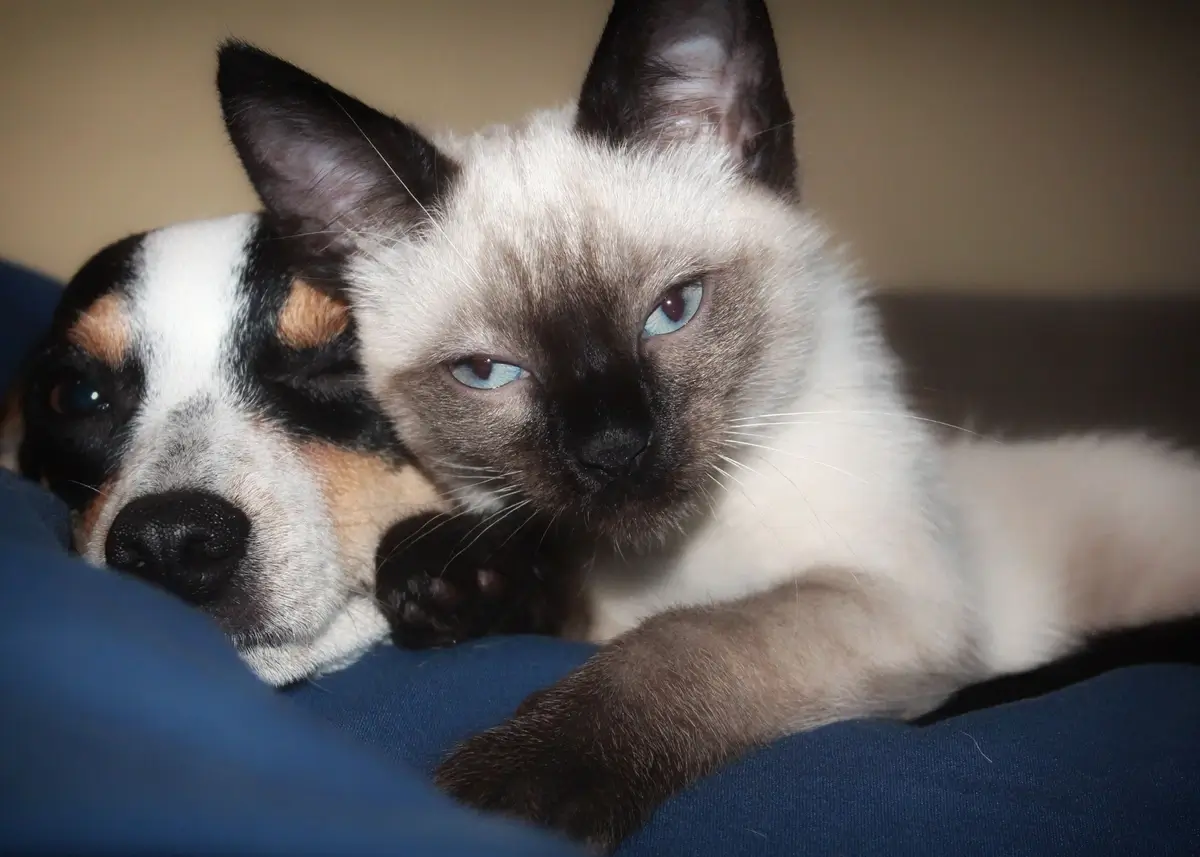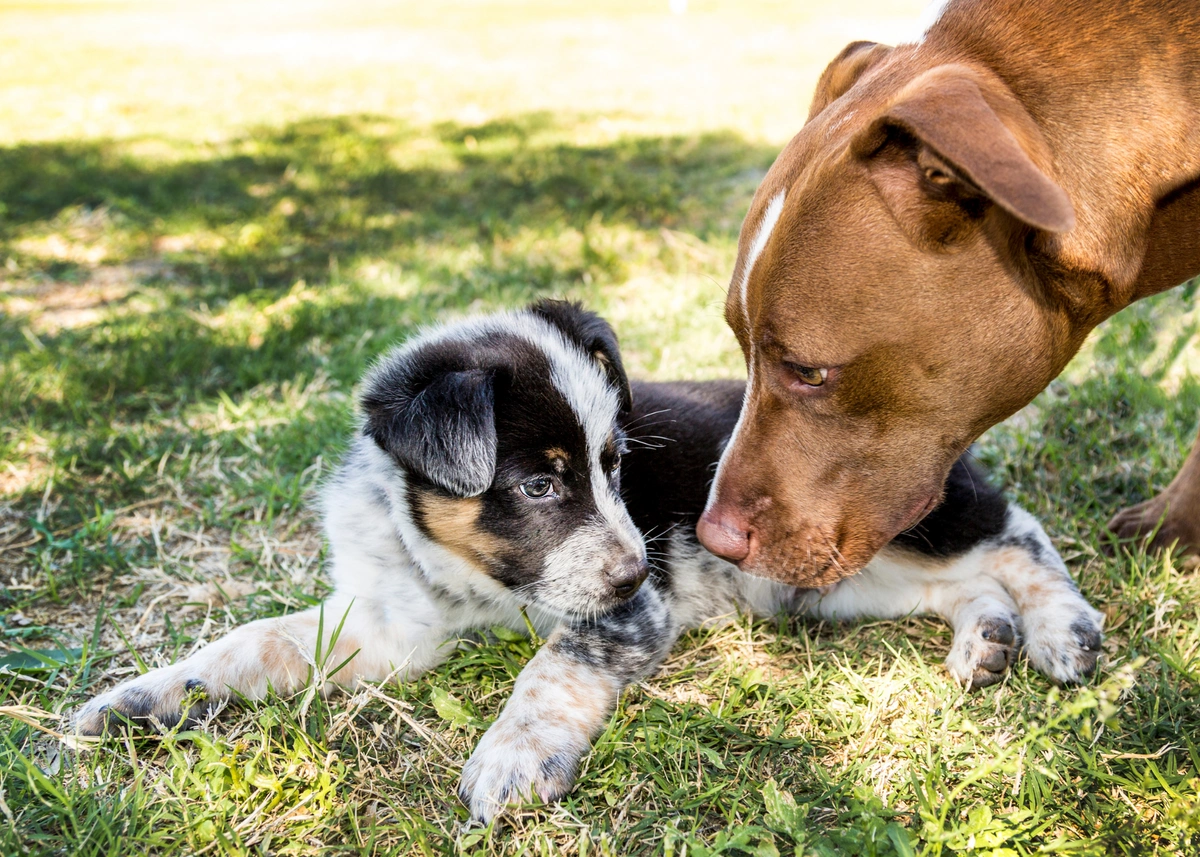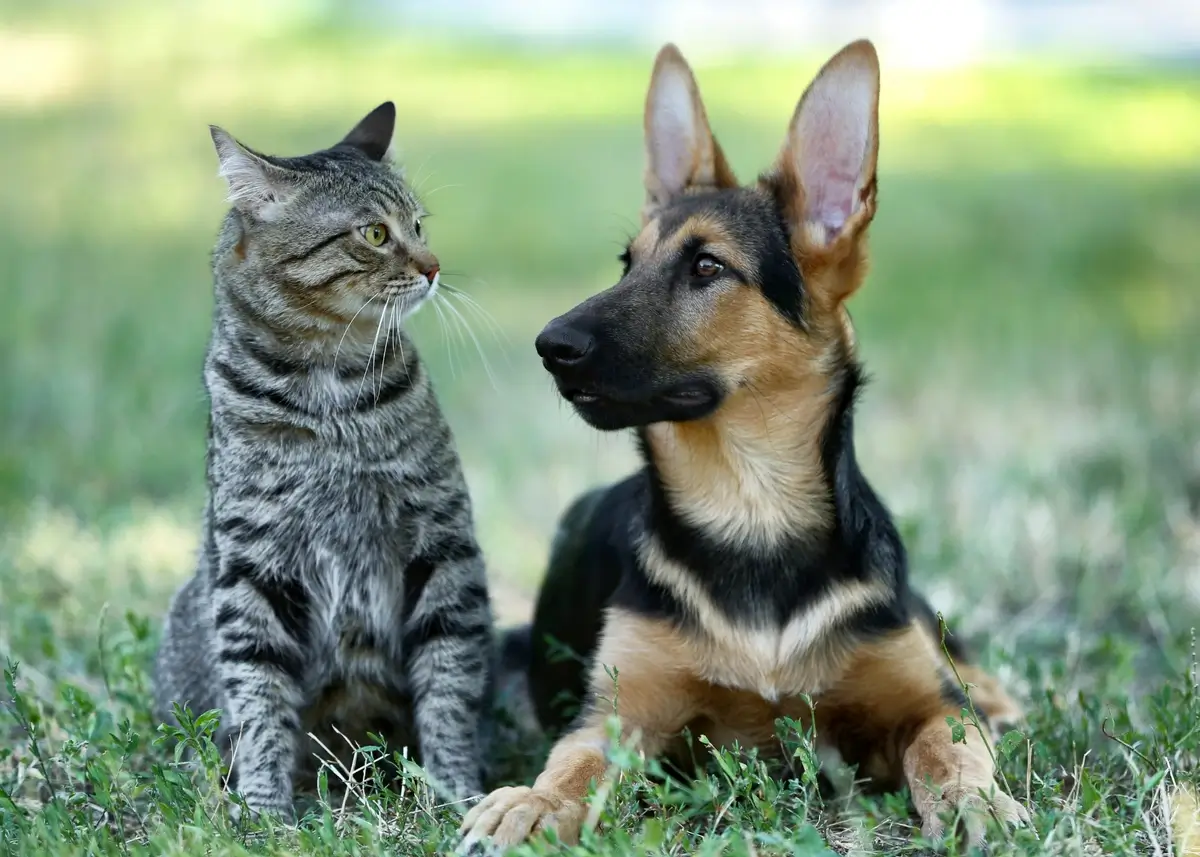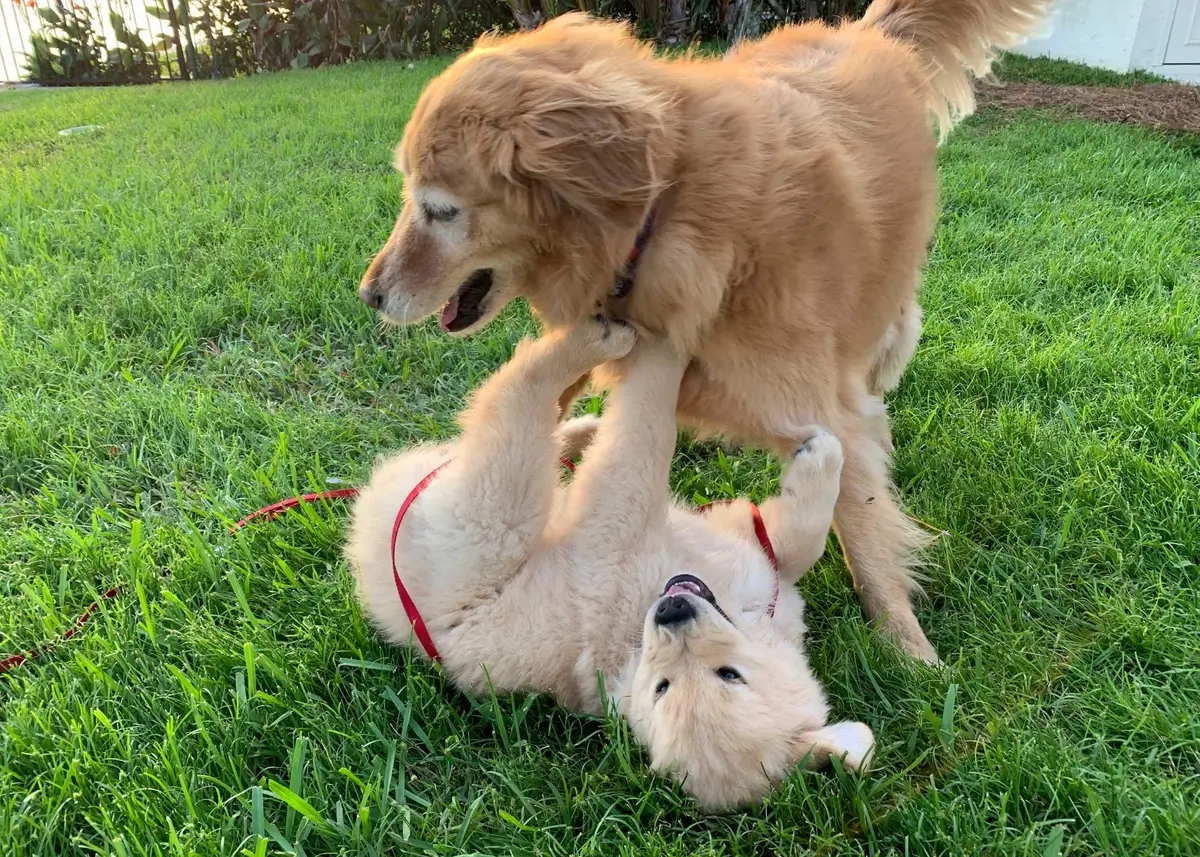If you’re already a pawrent, you know how much joy a furry companion can bring. The unconditional love shown in your strong bond with your pet is unlike any other feeling. Because your love knows no bounds, you’ve decided you need to share your love with another four-legged friend!
However, the day your new puppy arrives as your family member is NOT the first time you should be wondering about tips for introducing existing pets to a new puppy. After all, your dog or cat can’t consult with you on their opinion of adding an addition to the family, so you have to consider all aspects before selecting your puppy.
Whether you have a dog or a cat already, your pet will need to adjust to the addition of a curious, boisterous puppy. When you’re considering bringing home a puppy for sale, you need to think about all the members of your household – especially the animals you already live with. Follow our 13 tips for introducing your puppy to your current pets for a smooth process for all involved.
13 Tips to Consider When Introducing Your New Puppy to Your Current Pets
You can’t just wing it and hope for the best when it’s time to introduce your puppy to older pets in the household. With careful planning and a lot of thought, you can aim to have the most successful meeting possible.
1. Examine your assumptions
A prime factor in thinking about when your puppy meets an older pet is to identify your assumptions. Some people assume that just because you have 2 dogs means they will see each other as family members right away with a new pack member, but sometimes it takes a lot of work to get both used to the idea of each other around. While the stereotype might be that dogs and cats are enemies, quite the opposite can be true, and they can become inseparable. The key is to know your pet’s personality, prepare well, and take things very slowly for a successful introduction.
2. How are your pets with other animals?
Before you bring home your puppy, you’ll definitely want to think about how your existing pets interact with dogs and cats. Does your dog have a great time at the dog park, or are they reserved or agitated? Does your cat attack other dogs, or do they weave in between their legs purring? Knowing how your pets react to other animals will definitely help plan for your introduction.
3. Anticipate all scenarios
This exercise is a great topic to discuss with your household and brainstorm while sipping your favorite beverage. Think of all the ways the introduction could go, including the good, the bad, and definitely the ugly. It’s the time to play, “What if?” and entertain best and worst-case scenarios.
While it’s wonderful to be optimistic and only think positive thoughts, now is not the time to only view the future introduction through rose-colored glasses. You’ll need all the shades of the rainbow to make various plans!
4. Prepare the meeting space
Choose a neutral space in your home that is not associated with your pet’s favorite sunny spot. Make sure to pick up any toys, beds, or beloved objects belonging to your pet to minimize your pet becoming territorial. You may also opt to have the meeting space be an outside parallel walk using leashes or a fenced-in, secure location. Wherever it is, just make sure it’s a neutral space with very little distractions.
One middle ground between letting them fend for themselves or keeping them totally separated at opposite ends of the house for weeks is to use a baby gate, exercise pen, or crate. Your animals can smell and see one another and get used to their presence, observing the bouncing cotton ball with legs or sniffing the new puppy without getting pounced on. Provide a way for your older pet to escape or retreat if they desire.
Some people, especially with cats, have found that keeping a cat in a separate room with a door that closes is best to allow the cat to get used to all the hustle and bustle of a new puppy before even meeting the puppy. Providing a towel with a puppy scent can also help get your pet used to the new puppy’s smell.
5. Take introductions slowly
When you bring home your new puppy, he or she is there to live forever from that moment on. It is not practical for most of us to sequester our pets for weeks at a time with small amounts of daily exposure. In most cases, BAM! There’s another animal in the house! Adjustments can take weeks and months, not just a few days.
6. Don’t force interactions
It’s really important to not force anything when introducing a new puppy. Adjusting to a new puppy could be a challenge even for humans, so your pets that already live there will definitely need time to learn all about this new ball of fluff playing with their toys. You, your puppy, and older pets can all become quickly overwhelmed even with the best of circumstances, so don’t push through and force the meeting if things aren’t going well in the moment.
7. Stay cool, calm, and collected
Introducing pets to one another can be a frustrating process even when you are prepared. Pets feed off our energy. If we’re anxious, they absolutely will pick up on your negative vibes. Your pets look to you to be the leader of the pack. Even if you have to “fake it ‘til you make it,” never lose your cool and yell at your furbabies. Keep your emotions in check and remain upbeat and in control.
8. Supervise, supervise, supervise!
Remember how some people’s method of teaching someone to swim was to throw them out of a boat and hope for the best, letting them figure it out for themselves? Well, don’t take this approach when introducing pets to each other!
Never just put them in the same space and walk away, letting things play out naturally, or leave them unsecured at home together by themselves. You absolutely must be present to monitor how things are going. We know this may be silly to even mention in the first place, but we feel better for putting it out there!
In addition, don’t just stand there and watch things happen. Definitely intervene if one is bothering the other or if you sense the interaction is not going well. You can always try again with the goal being to protect the comfort of both animals. You do not want each pet to terrorize or antagonize the other or have them think this behavior is okay.
Putting your puppy on a leash gives you an extra layer of control in case your puppy becomes a little too curious or rowdy. Immediately separate animals if the meet-and-greet is not going well, put them in different secure locations in your home, and slowly but consistently try again.
9. Learn to understand dogs’ body language
By now, you have some knowledge of how to read your dog’s body language, especially when they interact with other adult dogs. However, you may not be sure how they will interact with a puppy or if you are interpreting their body cues correctly. What may seem like fighting is actually just playtime for them. You could misinterpret signs of anxiety and stress in both your older dog or cat and puppy.
10. Understand normal puppy behavior
Puppies going through the puppy teething stage will be learning all about bite inhibition. This is absolutely normal puppy behavior, and your older dog may not appreciate it at all or want to participate. Other dogs might love playing with their new fur sibling and teaching it the ways of how to be a dog. Educating yourself on normal puppy and older pet behavior can avoid unnecessary worry and actions.
While we may focus on the comfort of our current pets, don’t gloss over the fact that your new puppy is experiencing massive changes. They’ve just left the only home they’ve known with their mama and littermates forever and are taking in all new stimuli. Even without pets, the adjustment can be tough for little puppies who are learning about their new home, so give them some grace and understanding of what they’re going through, too.
11. Show lots of love to your older pet
A new puppy will definitely demand your attention literally day and night. Don’t let your pet feel left out! Make sure to spend quality time with your dog or cat to let them know you love them and to keep your strong bond.
There is a possibility that your older pet will regress or exhibit undesirable behavior. Your cat may pee outside its litter box or even get UTIs from stress. Cats are very sensitive and will instinctually respond to their environment, so you want to minimize stress as much as possible. Your older dog may have uncharacteristic behavior like growling or resource guarding.
12. Maintain your older pet’s routine
It’s important to keep your current pet on the same routine. There will be lots of chaos (whether good or bad) those first few weeks and even months, so the more normal and predictable your pet can expect the regular routine, the better experience your older pet will have adjusting to a new puppy.
Keep their same water and food bowl where it has always been. Consider separate feeding times as well. However, you never know if it's going to go well unless you try, especially if you would prefer them to be on the same feeding schedule. Don’t assume your new puppy can sleep in the same area as your existing pets – give them their own space. Don’t forget to walk and exercise your older pet! Mental and physical stimulation are necessary for their health. Make sure your older pet is current on all vaccines and has had a well visit recently to ensure the safety of all of your pets.
13. Train all pets for ongoing success
An introduction is not just one meeting. As we stated before, it will take a bit of time for everyone to adjust. In order to make the transition as smooth as possible, you need to train pets (well, as much as you can train a cat!) to respect one another’s boundaries.
Just like you would with a baby or toddler, you’ll need to protect your older pet from those razor-sharp puppy teeth or overexuberant play when it’s not welcomed. Teach your puppy basic commands like “stay” or “leave it” to guide your puppy toward desired good behavior. Give your older pet a break from the constant action by enrolling your puppy in a puppy kindergarten class for some socialization with dogs their own age.
Likewise, you’ll need to train your older pet to be gentle with the little one, working on eliminating any resource guarding from your dog or clawed swipes from your annoyed cat. It just so turns out you can teach an old dog new tricks!
Providing lots of treats and positive reinforcement for good behavior can go a long way. Every time your pets have a great interaction with one another, keep those treats and praise flowing to reinforce the behavior you expect from each of them.
Introducing Your Puppy to Other Pets in Your Household
While we’re focusing on just dogs and cats for now, we do want to acknowledge other pets such as bunnies, bearded dragons, gerbils, frogs, iguanas, snakes, parakeets, ferrets, hedgehogs, and many more non-traditional pets that bring us great joy and comfort. You might also keep livestock as pets, such as horses, cows, goats, and chickens. You may even have llamas and alpacas that rival the softness of your puppy’s fur!
Introducing your puppy to these types of unique pets may require different techniques, but you’ll find the general concept of canine and feline introductions to be relevant overall to other mammals, reptiles, amphibians, and others. Depending on your puppy’s breed, you may need extra supervision around small animals, as your puppy may think they are prey or game to be hunted and may not understand how to be gentle.
Find a Pawrade Friend For Your Pet
Life is better with a best buddy, and what better way to give your pet a lifelong friend than with a new puppy? We offer puppies for sale from trustworthy breeders to fit in with all the members of your family, including those of the four-legged variety. Several of our team members have more than one pet and have been through the process of adding a new puppy to their families, so let us help you find the perfect new family member!








